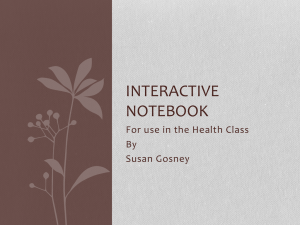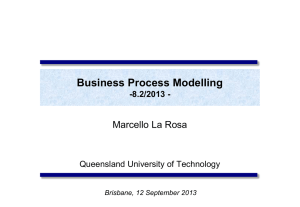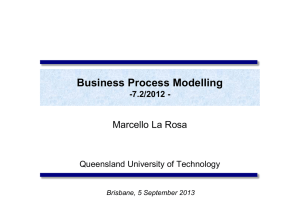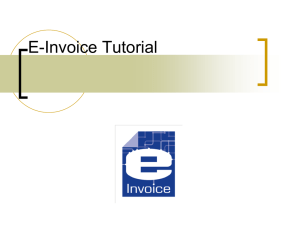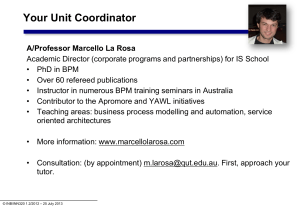Part 1 - Fundamentals of BPM
advertisement
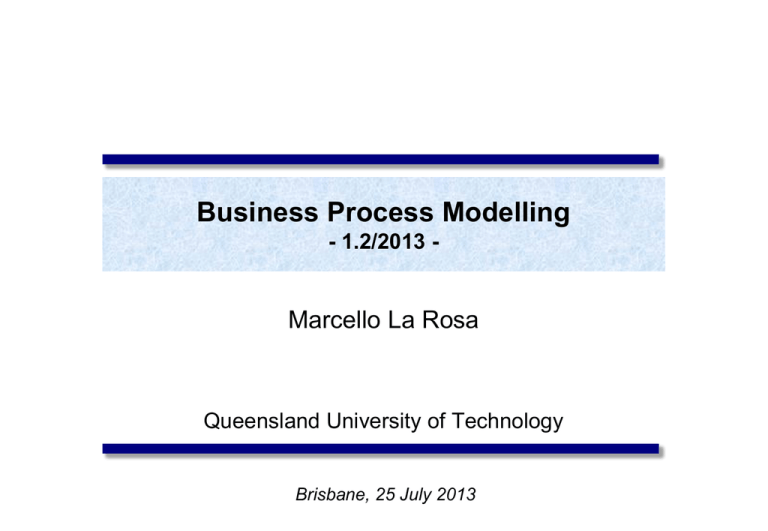
Business Process Modelling - 1.2/2013 - Marcello La Rosa Queensland University of Technology Brisbane, 25 July 2013 How novices model a business process Mark is going on a trip to Sydney. He decides to call a taxi from home to the airport. The taxi arrives after 10 minutes, and takes half an hour for the 20 kilometers to the airport. At the airport, Mark uses the online check-in counter and receives his boarding pass. Of course, he could have also used the ticket counter. He does not have to check-in any luggage, and so he proceeds straight to the security check, which is 100 meters down the hall on the right. The queue here is short and after 5 minutes he walks up to the departure gate. Mark decides not to go to the Frequent Flyer lounge and instead walks up and down the shops for 15 minutes and buys a newspaper before he returns to the gate. After ten minutes waiting, he boards the plane. © INB/INN320 1.2/2012 – 25 July 2013 Many ways of modelling a process… © INB/INN320 1.2/2012 – 25 July 2013 Many ways of modelling a process… © INB/INN320 1.2/2012 – 25 July 2013 Many ways of modelling a process… © INB/INN320 1.2/2012 – 25 July 2013 Many ways of modelling a process… © INB/INN320 1.2/2012 – 25 July 2013 Many ways of modelling a process… © INB/INN320 1.2/2012 – 25 July 2013 Many ways of modelling a process… © INB/INN320 1.2/2012 – 25 July 2013 Issues? • • • • Different representation of concepts Different level of granularity Different level of scope Different terminology → What is the right process model? © INB/INN320 1.2/2012 – 25 July 2013 What is a model? Ship goods Prepare shipment Archive order (Re)send bill Register order Receive payment Requirement for material has arisen Purchase Requisition Contact customer Requisition released for scheduling agreement schedule/SA release Purchase requisition released for purchase order Purchasing Enter Invoice Details Check Invoice Mismatches no mismatches Post Invoice Invoice received Goods received mismatch exists Inbound delivery entered Purchase order created Material is released Invoice received Block Invoice Goods Receipt Goods receipt posted Warehouse/ Stores TO item confirmed without differences Transfer order item is confirmed Invoice Verification Payment must be effected © INB/INN320 1.2/2012 – 25 July 2013 A little bit on modelling theory Models are abstractions from real world phenomena, developed for the purpose of reducing overall complexity. Models aggregate information and document only relevant aspects of the real world. Models are being developed in a specific modelling subject for a specific target audience with a specific modelling purpose in mind. no right/wrong, but relevant/irrelevant model © INB/INN320 1.2/2012 – 25 July 2013 What is the relevant model? ? © INB/INN320 1.2/2012 – 25 July 2013 Our Phenomena of Interest: Business Processes Collection of related events, activities and decisions, that involve a number of actors and objects, and that collectively lead to an outcome that is of value to an organization or its customers. Examples: • Order-to-Cash • Quote-to-Order • Procure-to-Pay • Application-to-Approval • Fault-to-Resolution (Issue-to-Resolution) • Claim-to-Settlement © INB/INN320 1.2/2012 – 25 July 2013 Dumas, La Rosa, Mendling, Reijers, 2013 “My washing machine doesn’t work…” Insurance Company Call Centre Technician Customer Customer fault-to-resolution process © INB/INN320 1.2/2012 – 25 July 2013 VALUE Service Dispatch Centre Parts Store Processes and Outcomes • Every process leads to one or several outcomes, positive or negative – Positive outcomes deliver value – Negative outcomes reduce value • Fault-to-resolution process’ outcomes: 1. 2. 3. 4. 5. 6. Fault repaired without technician intervention Fault repaired with minor technician intervention Fault repaired and fully covered by warranty Fault repaired and partly covered by warranty Fault repaired but not covered by warranty Fault not repaired (customer withdrew request) © INB/INN320 1.2/2012 – 25 July 2013 What is a Business Process: Recap © INB/INN320 1.2/2012 – 25 July 2013 The Core Elements of a Process • Activities – active elements (e.g. ‘enter sales order’) – time-consuming, resource-demanding – state-changing • Events – passive elements (e.g. ‘sales order has been entered’) – represent conditions / circumstances – atomic, instantaneous © INB/INN320 1.2/2012 – 25 July 2013 17 The Core Elements of a Process • Business Objects (or Data) – the organizational artifacts that undergo state changes – physical or electronic information – examples: • sales order, digital object, consulting proposal • Actors (or Resources) – the entities performing process activities and generating events – human and systems – examples: • financial officer, warehouse clerk • ERP, CRM, SAP, application X… © INB/INN320 1.2/2012 – 25 July 2013 18 How do we combine these? 1. What needs be done and when? - Control flow 2. What do we need to work on? – Data 3. Who’s doing the work? - Resources (human & systems) Finance ERP Department Invoice Invoice received Enter Invoice Details Report Check Invoice Mismatches Invoice DB Invoice no Post Invoice mismatches Invoice posted Invoice Senior Finance Officer mismatch exists Block Invoice Invoice blocked © INB/INN320 1.2/2012 – 25 July 2013 Process Perspectives • Control Flow Perspective Invoice received Enter Invoice Details Check Invoice Mismatches – “what needs to be done and when” – predecessor/successor relationship among activities and events – the central information depicted in a process model no Post Invoice mismatches Invoice posted mismatch exists Block Invoice Invoice blocked • Data Perspective – “what do we need to work on” – input/output data to activities – complements the control flow Invoice Report Invoice DB • Resource Perspective – “who’s doing the work” – human participants and systems that perform control flow activities and generate events – complements the control flow © INB/INN320 1.2/2012 – 25 July 2013 Finance ERP Department Senior Finance Officer 20 Example: Student Enrollment Complete preenrolment © INB/INN320 1.2/2012 – 25 July 2013 Set up online access Accept offer and T&C Plan enrolment Enrol Register for classes 21 Further Potential Elements in a Process • Objectives, Goals – link to strategy • Risks – for risk-profiling the process • Policies, Rules – for checking process compliance • Knowledge – to depict expertise required • … © INB/INN320 1.2/2012 – 25 July 2013 22 Process Modelling… • • • • • is a common language for naming and framing an issue integrates processes with other artefacts (e.g. systems, organisations, data, services, risks) enables walk-through, validation and testing (e.g. via simulation) can be used as a benchmark for measuring improvements – “what-if” analysis provides a blueprint for process automation Adapted from Davis, 2000; Wreden, 1998 © INB/INN320 1.2/2012 – 25 July 2013 23 Why Process Modelling? • Business processes are increasingly valued as essential assets of an organisation • This significance demands dedicated management of processes • We need ways to extract processes out of the organisational complexity in order to discuss, analyse, improve and automate them © INB/INN320 1.2/2012 – 25 July 2013 24 Where does process modelling fit in BPM? Body of principles, methods and tools to design, analyze, execute and monitor business processes, with the ultimate goal of improving them. IT systems Customers People Organizational Business Processes Trading Partners Data IT infrastructure © INB/INN320 1.2/2012 – 25 July 2013 Suppliers Dumas, La Rosa, Mendling, Reijers, 2013 Where does process modelling fit in BPM? …design, analyze, execute and monitor business processes… Process identification Focus of this unit Conformance Conformance and and performance performance insights insights Process Process architecture architecture Process discovery As-is As-is process process model model Process monitoring and controlling Process analysis Executable Executable process process model model Process implementation © INB/INN320 1.2/2012 – 25 July 2013 Insights Insights on on weaknesses weaknesses and and their their impact impact To-be To-be process process model model Process redesign Time Investment in BPM Projects Process Discovery 9% Project Team Selection 4% 11% Business Case Deployment and Training 12% Testing and Debugging 41% Implementation Tool Evaluation and Selection 7% Functional and Technical Specification 8% 5% 3% Project Documentation BPTrends, 2006 © INB/INN320 1.2/2012 – 25 July 2013 Top 10 Technology Skills • • • • • • • • • • Business Process Modelling Database Messaging/Communications IT Architecture IT Security Project Management Data Mining Web Development IT Optimization Networking NetworkWorld, 30 March 2009 © INB/INN320 1.2/2012 – 25 July 2013 28



